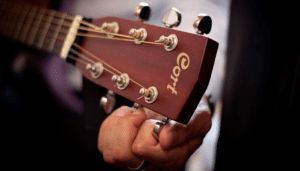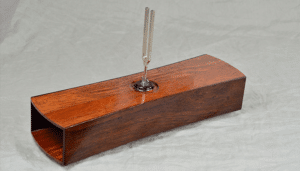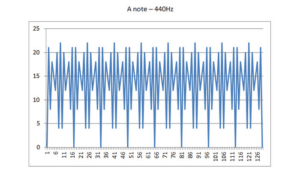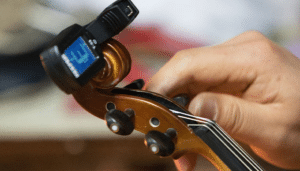Have you ever wondered why a particular note on a piano sounds the way it does? Or how do we come up with the tuning standards that allow bands and ensembles to play together to create unique and easily reproducible harmonies?
As with many other aspects of life, reaching a tuning standard in music has been a highly heated debate that transcended different fields, from music theory to physics, philosophy, and even magic.
For two thousand years, human beings tried to reach an agreement on what the particular frequency standard for tuning instruments should be, until in the 20th century, when the majority of the music world agreed on specific tuning parameters for standardized pitch.
However, this reference pitch is far from being set in stone. Today, music theorists and audiophiles alike challenge the status quo and question the most widely accepted tuning standard. The reasons behind the disagreement are many, and some quite far-fetched.
Still, there are thousands of musicians and composers worldwide who believe the tuning frequency used by the majority worsens the audio quality of music and is not in harmony with the frequencies of the universe.
Hence, today I’ll analyze the big debate between the tuning in A4 = 432 vs 440 Hz, A4 being the A note just above middle C and the pitch reference for standard tuning. First, I’ll cover some background history and how we got to 440 Hz for our musical instruments.
Then, I’ll describe the reasons behind the “432 Hz movement”, what you can do to hear the difference for yourself, and how to tune your musical instruments to a different pitch, whether real or digital.
By the end of this post, you’ll be able to identify which tuning standard will work best for your compositions, why some musicians opt for a different reference pitch, and the best frequencies to open your chakra and be one with the universe. Not too bad for just one article, right?
Let’s dive in!

Let’s start with the basics. Tuning for most instruments today is extremely simple, as you just need a digital tuner or an app to do it yourself in seconds. However, things get more complicated with pianos and classical instruments in general, which require practice, patience, and the right tools like a special lever and an electronic chromatic tuner.
But before the beautiful digital era we live in, instruments had to be tuned manually so that each note would reproduce a determined pitch, and the same note played on different instruments would hit the same frequency.
Tuning means adjusting the pitch of a particular note until its frequency is identical to the reference pitch. Musicians use this tuning system to ensure their instruments are not “out of tune” and, therefore, will seamlessly blend with other instruments following the same tuning standard.

The invention of tuning forks in 1711 offered the first opportunity to standardize the pitch. By striking tuning forks against a surface, it resonates at a specific constant pitch, which can be used to align the note of a musical instrument to the frequency reproduced by the tuning fork.
What about the thousands of years of music preceding the 18th century? Musicians were primarily using ratios and intervals to tune their instruments, and there were some tuning techniques like the Pythagorean tuning used for centuries in Western music.
Before the 18th century, one of the most commonly used tuning systems was the so-called Pythagorean tuning. This tuning had a frequency ratio of 3:2, which allowed perfect fifth harmonies and, therefore, a more straightforward approach to tuning.
For example, using this frequency ratio, a D note tuned at 288 Hz would give an A note at 432 Hz. This particular tuning approach developed by the great Greek philosopher evolved into the Pythagorean temperament, a system of musical tuning based on perfect fifth intervals.
Although you may still hear music tuned in this way in modern classical music, Pythagorean tuning is considered outdated as it works only for four consonant intervals: unisons, fourths, fifths, and octaves. This does not consider all the major/minor intervals commonly used in modern music. The complexity of contemporary music made the Pythagorean temperament obsolete.
For the last three hundred years, the A4 note, which is the A above the middle C on the piano, has been used as the tuning standard for Western music. Until the 21st century, there was no agreement between different composers, instrument makers, and orchestras on which frequency A4 should be.
Beethoven, Mozart, Verdi, and many others varied widely and would tune their orchestras differently, deliberately choosing between 432 Hz, 435 Hz, or 451 Hz, depending on personal preference and the tune that would best fit their compositions.
Two critical discoveries helped humanity define a standardized pitch: the discovery of electromagnetic waves and the universal definition of a second.

Heinrich Hertz proved the existence of electromagnetic waves in 1830. When it comes to sound, one Hertz represents one cycle in a sound wave per second. 440 Hz, the standard pitch used for the A4, means 440 cycles per second. 432 Hz means as you might guess, 432 cycles per second.
As the unit of time, the second became the international standard unit in the late 16th century. Without the concept of a second, there was no way of willingly tuning musical instruments at specific frequencies because we define one Hertz is one cycle per second.
Before the standardization, each composer would tune their instruments and orchestras at different pitches. For instance, before becoming an advocate of 432 Hz, Italian composer Giuseppe Verdi would use A4 = 440 Hz, Mozart at 421.6 Hz, and Beethoven’s tuning fork resonated at 455.4 Hz.
In the 19th century, the world of Western music gradually started heading toward tuning standardization. Still, it wouldn’t be until the following century that the orchestra worldwide agreed on a unique reference pitch, thanks to the International Organization for Standardization.
Decades before the universal standardization of the 20th century, the French standard of 435 Hz became the most commonly used frequency. In 1855, Italy opted for A4 = 440 Hz, and the United States followed suit by the beginning of the 20th century.
In 1939, the International Organization for Standardization recognized 440 Hz as the standard concert pitch. This is how A4 = 440 Hz became the tuning standard of all instruments we use today, both analog and digital.
Today, most of the music you hear broadcasted on the radio or live at a concert hall use 440 Hz as a reference pitch. However, there are many exceptions, like the Boston Symphony Orchestra, which uses 441 Hz, and orchestras in Berlin and Moscow, which go up to 443 Hz, and 444 Hz.
So, is this the end of the story? Not at all.
432 Hz is an alternative tuning system first suggested by French philosopher Joseph Sauveur in 1713 (more about him later). The Italian composer Giuseppe Verdi recommended this reference pitch as the standard for orchestras in the 19th century.
Although the worldwide music community agreed to use A4 = 440 Hz as the primary tuning reference, many musicians and audiophiles claim that music at A4 = 432 Hz sounds better, richer, and more relaxing.
Others believe that 432 Hz is more in line with the frequency of the universe and the Earth’s natural frequency pulsation. As described by the Schumann resonance, the fundamental frequency of Earth’s electromagnetic waves resonates at 7.83 Hz, so very close to 8, a number that supporters of 432 Hz like very much for its symbolic meaning.
Although the 432 Hz movement has been going on for quite some time, the last couple of decades saw its supporters fighting with renewed energy because of the supposedly healing powers this frequency has and the benefits it can provide to listeners.
As musical notes with a lower frequency result in a lower pitch, if you lower the frequency of A4 to 432 Hz, you’ll end up with an A4 that sounds 8 Hz lower than the frequency standard. So there’s a significant difference between an instrument tuned at 440 Hz and 432 Hz, which you can hear even without a superb relative pitch.
Remember that A4 = 432 Hz doesn’t mean that A4 is the only note you’ll need to adjust to change the reference pitch. In order to have a musical instrument that genuinely sounds at 432 Hz, you’ll have to lower the frequencies of all notes, using the A4 as a point of reference.
Check out this video to hear the difference on the same piece using alternate tuning: https://www.youtube.com/watch?v=74JzBgm9Mz4&t=108s

The note A4, above middle C, has been used as the reference note for the past three hundred years. Before the standardization, composers could tune A4 anywhere between 400 and 480 Hz (including 432 Hz) and adjust the rest of the frequencies accordingly.
Although the music community agreed to the concert pitch at 440 Hz, you can choose to tune your instruments at different frequencies to improve the quality of your music. There’s no rule against it, and in fact, it can help you expand your sonic palette and create unique soundscapes.
You can tune your instrument at 432 Hz, 440 Hz, or 455 Hz. The reference pitch you choose is entirely up to you, so long as you ensure that others can easily reproduce the music you make, should you become the next Beethoven.
There are two main reasons why some musicians and audiophiles prefer the 432 Hz tuning: one is based on a (theoretical) improvement in sound quality, while the other is more of a spiritual choice.
Let’s start with the former. Instruments tuned at a frequency lower than 440 Hz, such as 432 Hz, may result in a warmer, deeper sonic experience simply because that’s a characteristic of lower frequencies. The difference in Hertz is minimal but is there, and you can check for yourself how these two tuning standards sound here.
One of the main arguments against the 440 Hz is that by using this tuning, the eight octaves of C end up with some fractional numbers; whereas, at A4 = 432 Hz, the eight octaves of C would all result in mathematically consistent whole numbers: 32 Hz, 64 Hz, and so on.
Initially conceived by French physicist Joseph Sauveur, called this approach the scientific pitch or Sauveur pitch; it sets the C4 to 256 Hz rather than the standard 261.62 Hz, giving simpler integer values when tuning.
Some people claim that we should listen to music at the pitch initially conceived for the song, which I think makes perfect sense. Whenever possible, this has been done by many classical orchestras who tune their instruments based on the tuning fork of the composer or the historical evidence we have at our disposal.
Now comes the spiritual aspect of the debate. People claim the 432 Hz has some remarkable healing properties resulting from this frequency being in line with the frequency of the universe. Often people claim that music at 432 Hz is relaxing and ideal for meditation thanks to its calmer, softer tones.
Conspiracy theories abound. Some people claim A4 = 440 Hz was initially adopted by military groups and then promoted by Nazi Germany; others claim that 432 Hz has some spiritual healing properties and resonates with the human body’s cells, healing it.
You can find all sorts of mathematical “evidence” online in favor of using A4 = 432 Hz and explanations on how this frequency will help you open your chakra and third eye.
In a nutshell, some think music at 432 Hz actually sounds better, while others believe this frequency has unique properties that help you feel better.

While all digital tuners use the standard 440 Hz tuning, most of them allow switching the frequency to 432 Hz effortlessly. If you use any app, just check the settings to adjust the tuning frequency. If you’re playing the guitar and using a chromatic tuner pedal, you should locate the settings button and change the frequency.
For classical instruments, you can buy a 432 Hz tuning fork and use it to tune musical instruments. If you play in an ensemble, make sure all other musicians tune their instruments at 432 Hz; otherwise, you’ll sound out of tune.
Many websites can convert music from 440 Hz to 432 Hz for free. You can also do it yourself using a DAW (digital audio workstation) like Ableton or Logic Pro. On a DAW, you can either change the settings of a single track or do it for the entire piece via the master track.
Perhaps the easiest way to convert the frequency to 432 Hz by yourself is by using the free DAW Audacity, which allows you to change pitch in audacity without affecting the tempo by using the Change Pitch effect.
You can follow this procedure for tracks you created or even songs made by famous artists. Do you want to hear how they sound at 432 Hz? Now you have the chance to convert them to a different frequency and listen to the same piece at a different pitch.
All VST plug-ins use the tuning standard of 440 Hz. All VST synths should have an oscillator pitch section. To reach 432 Hz, you should lower the oscillator knob by -32 cents or as close as possible to it. If you’re using multiple instruments, they should all be set at 432 Hz.
As I mentioned in the previous section, you can also record each instrument and then change the pitch using Audacity. If you use Ableton, you can adjust the oscillator pitch section of all your instruments and then save it as the device preset. In this way, you won’t have to change the settings every time.
I hope this article helped clarify the debate between these two tuning standards. I also hope that my personal preference didn’t affect your views on the matter too much.
Many believe music at 432 Hz sounds richer and warmer. Partially, I believe it’s true as lower frequencies tend to sound deeper, so a slight variation in the pitch might give the impression the song sounds better.
The fact that we have a standard tuning at A4 = 440 Hz doesn’t mean that all musicians have to use the same pitch or that 440 Hz is universally accepted. In fact, dozens of orchestras worldwide choose to tune their instruments differently, somewhere between 440 Hz and 444 Hz.
Although you shouldn’t blindly follow the standardized pitch used for the last few decades, choosing the 432 Hz tuning because of its so-called healing properties is a choice that has little to do with music and more with spiritual beliefs.
If you do a quick search online, you’ll find a plethora of articles about the topic. However, I’d advise you to choose carefully what you decide to read and avoid any kind of conspiracy theory, as some of these articles were clearly written by flat-earthers with a vague musical background.
On the other hand, some draw an interesting comparison between the different pitches and give valuable information that you can use for your music-making progress.
A4 = 432 Hz is often used for yoga and meditation: so if you’re into ambient music, you should try this lower pitch and see if it adds depth to your sound.
I believe that trying various tunings and changing the pitch of your song may add variety to your sound and make it more unique. Since all DAWs provide the option to change pitch, why don’t you give it a try and see how your tracks sound?
I’d also suggest you have someone else listen to your adjusted songs, just to ensure your views won’t affect your opinion on the song’s sound. Try not to be influenced by the current debate and focus on your main objective: to make unique music that sounds the best it possibly can.